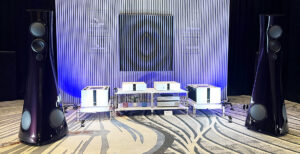
Good audio has an element of split personality to it. This is understandable, as “it’s a broad church” as we say in Britain. There’s room in good audio for people with turntables and tube amps, for people with high-res files running of a state-of-the-art portable player, and all points between those two poles. But, underlying that, there seems to be a deep schism between two almost conflicting stances in modern audio. I call them the ‘boutique’ and the ‘bait store’, although neither necessarily has anything to do with an actual store.
The ‘boutique’ product is designed with design in mind. The boutique product looks elegant, fits into modern surroundings, is easy to use, reliable, doesn’t need a PhD in electronic engineering to turn it on, won’t immolate the cat if you press the wrong button, and won’t burn the house down if you leave it unattended for five minutes. The Devialet 170 pictured above is a perfect example of this ‘next gen’ product.
On the other hand, the ‘bait store’ product is designed by and for enthusiasts. The bait store product pays no attention to domestic considerations, looks like it was ripped from the SONAR room of a 1940s German U-boat, has the kind of sharp-edges designed to flay the lower limbs of passing six-year-olds, is filled full of devices that can simultaneously cut, burn, and electrocute you if things go the least bit wrong, and has delivered the kinds of shock that you have to turn it on with a long stick and keep a fire extinguisher on hand.
Traditionally, the rationale for ‘bait store’ products was completely understandable; the alternative was all style over substance and didn’t sound any good. Those dedicated electronics designers put their heart and soul into what goes on under the hood, and the rest was just superfluous gift-wrapping. There were exceptions and there have always been boutique products that sounded good, and bait store products that sucked. But, in the main, the products that looked good often didn’t sound that good and vice versa.
That’s all changed. For good or ill, we live in a design-led world now, and for a product to survive in the real world, it has to perform both in form and function. Apple is not at its zenith today, but its still the most important driving force in consumer electronics design, and it informs the products we use as a result, even if they are entirely unrelated to Apple’s product portfolio. Companies in the audio business have reacted to this increased understanding of basic design in the wider world, and we have many products that sound as good as they look.
So why do products that look like they were thrown together in a shed still exist?
In part, it’s because there are still audio designers who consider the circuit all-powerful and everything else is unimportant. The money spent in design was spent on the way it sounds, not how it looks. Which is notionally how it should be, except you can end up with the best sounding product that doesn’t sell if it’s too ugly. But mostly, it’s us being conservative – our products always looked this way, and they always will. This is not simply inertia on the part of the company; just ask anyone from Audio Research how changing from black to silver handles went down with its followers.
However, there is also a peculiar inverse logic that springs from this: the more ugly the product, the better it sounds. There is no real evidence for this, but it’s unremittingly pervasive. We curmudgeonly British are particularly good at clinging to this mindset, managing to convince ourselves that an amplifier that looks like it has been fired out of a cannon must sound good, because no money was spent on its looks. This gives rise to a haughty dismissal of anything not looking like a bad day at the hammer factory, as being ‘design-led’ and ‘not sounding any good’… often said without any need for actual listening to take place.
As I said at the beginning, “it’s a broad church”. If audio is ever going to appeal to those beyond its ever-shrinking circle of enthusiasts, those products that look as good as they sound need to not fall victim to unwarranted criticism from those who are willing to put up with poor design for its own sake. Design might not be important to you, but that isn’t much of a boast today.
Who knows, maybe those good-looking products sound good too.
Tags: FEATURED
By Alan Sircom
More articles from this authorRead Next From Blog
See all
AXPONA 2024 Show Report Part One
- Apr 19, 2024

Audio Show Deluxe 2024: A photo show report
- Mar 28, 2024

Paul Messenger 1949-2024: A personal tribute
- Mar 26, 2024

Bristol Hi-Fi Show 2024: See You There!
- Feb 21, 2024










